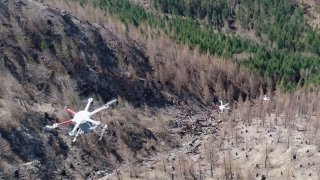
- Forest restoration is now becoming a focal point for an increasing number of investors in climate resilience.
- "We're a one-stop shop for reforestation," said Grant Canary, CEO of DroneSeed.
- Since the start of this year, 32,247 wildfires have burned over 3.3 million acres in the United States.
Fire seasons are now longer and the destruction more intense, as fires burn hotter and spread to more drought-stricken ground. Since the start of this year, 32,247 wildfires have burned over 3.3 million acres in the United States, according to the National Interagency Fire Center. An early start to the season, and an especially brutal beginning in New Mexico, puts 2022 on the path toward record fire destruction.
Historically, fires would leave seeds in the soil and at treetops, but the hotter, more intense fires that occur now burn up the treetops and destroy the seeds in the soil, so there is much less natural regeneration.
DroneSeed is a Seattle-based startup that claims it can begin to restore thousands of acres of wildfire-ravaged land just 30 days after the fire is out.
"We're a one-stop shop for reforestation," said Grant Canary, CEO of DroneSeed. "If you're a land manager, and this could be tribal nations, this could be family forests, this can be public lands, this can be timber companies, and you're affected by a wildfire, we're one of your phone calls."
DroneSeed uses seeds as well as seedlings, or young plants, from its own nurseries. It then uses heavy-lift drone swarms to spread them across the scorched land. The drones drop the seeds in contained vessels, called pucks, where they then root and begin to grow into seedlings. These pucks are made out of plant fiber and contain nontoxic elements, such as spicy pepper, to deter rodents and other mammals.
Money Report
Not all of the seeds or seedlings result in trees, and DroneSeed said that seed establishment and growth rates vary at each project site, due to soil conditions, water quality, grade of the terrain, climate temperature, tree species and other factors.
Canary likens his fleet of drones to a swarm of bees, navigating rough terrain, that can carry and disperse many thousands of seeds. Each aircraft can plant three-quarters of an acre per flight. In October 2020, the company announced that it was the first to receive approval from the Federal Aviation Administration for this type of forest-seeding activity.
Get a weekly recap of the latest San Francisco Bay Area housing news. >Sign up for NBC Bay Area’s Housing Deconstructed newsletter.
"The aircraft themselves, they are not what you can get at Best Buy. They're eight feet in diameter," said Canary. "They carry a 57-pound payload. We operate them in groups of three to five, and they're going out there and they're dropping seed vessels onto the landscape in pre-surveyed areas."
Key to DroneSeed's model is the seedling production, which has been a major barrier to reforestation due to supply chain issues. DroneSeed recently purchased Silvaseed, one of the oldest seed businesses in the nation, and it is now expanding to become the largest private seed banks in the West, growing millions of seedlings.
The company's operations are funded in part by companies purchasing carbon offsets. One such customer is Shopify, which bought enough to remove 50,000 metric tons of carbon from the atmosphere. In turn, DroneSeed is replanting 300 acres of forest lost in Oregon's Beachie Creek fire two years ago.
"That climate benefit of planting those trees and drawing down carbon is what we're purchasing through our carbon credit purchase," said Stacy Kauk, Shopify's head of sustainability. "That allows us to balance out our unabatable emissions from our corporate footprint, such as things like electricity usage or corporate travel."
DroneSeed is backed by 776, DBL Partners, Social Capital, Spero Ventures and Techstars. It has raised $36 million to date.






